In Genesis R&D Supplements, “Components” are the building blocks of Ingredients. Everything the program does requires that you start with Components.
So, this blog is going to take a closer look at Components and explore:
- What a “Component” is and how it’s used
- How to create a user-added Component and use it in an Ingredient
- How to use that Ingredient to build a Formula
- What a user-added component looks like on your Supplement Facts label
- How to modify how Ingredients and Components to appear on your label
Overview of Components in Genesis R&D Supplements
Components are those elements that comprise Ingredients. They might be nutrients that have a DRV or an RDI or other dietary ingredients, such as herbs. Components can be active or inactive.
Active components are any that may be displayed on the Supplements Facts Label.
Inactive components are those such as water and ash and fillers, that will not be displayed on the Supplement Facts label, although they may affect the nutrient analysis of the Formula.
Genesis R&D Supplements comes pre-populated with more than 131 components, including mandatory and voluntary nutrients (i.e. Calories, Vitamin C, Zinc, etc.), as well as other components that can make up an Ingredient (i.e. water, caffeine, fillers, etc.). You can view the full list of components in the user manual.
If the program doesn’t have a particular component, Genesis R&D Supplements allows you to create your own components on the fly from the Ingredient entry screen.
Creating Ingredients and Components
This blog is going to use the creation of a melatonin and magnesium capsule as an example.
- Go to New > Ingredient.
- Name the Ingredient “Melatonin Powder” and select 100g as the reference amount. Our sample nutritional datasheet states that the nutrient composition is 97% melatonin and 3% water per 100g.
- Press Enter.
- Now start typing “melatonin.” Note that when you type “melatonin,” it’s italicized and greyed out. That’s because this component is not included in the program and has not been previously added.
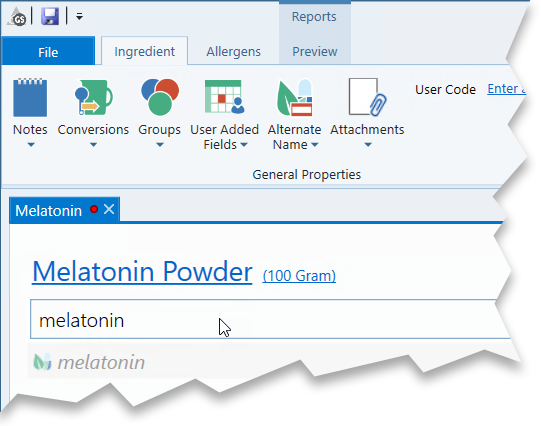
- Select the italicized “melatonin” to create melatonin as a new component.
- Enter the amount — 97% from the nutritional data sheet — and select active.
- Now, start typing “water.” Note: “water” appears in a regular font and is automatically added as inactive. This is because it is included as a component in Genesis R&D Supplements.
- Enter 3%.
- Save and close this Ingredient.
Creating a Formula with Ingredients (and their Components)
To see how the Components will appear on your label, you first need to create a Formula using the Ingredient entered.
- Go to New > Formula.
- Name the Formula “Melatonin + Magnesium.”
- Enter your Ingredient. Start typing in “melatonin” and you’ll see the Melatonin Powder ingredient you just created.
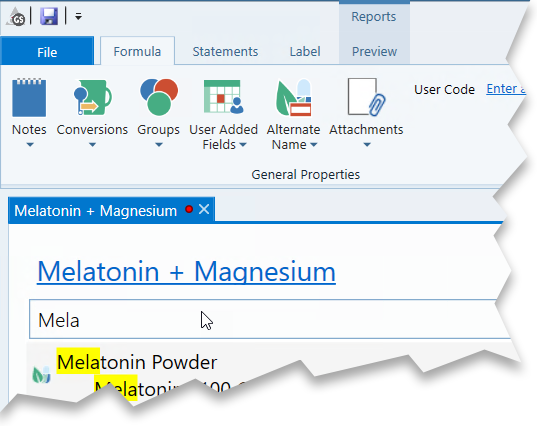
- Select the Ingredient and enter an amount. In this example, that’s 5mg.
- Now, enter the Formula’s other Ingredient — Magnesium Citrate — at 808 mg. This will provide 100 mg of Magnesium in the supplement.
- Click Save.
Supplement Facts Label with Ingredients and Components
Now take a look at your Supplement Facts label to see how the Ingredients and Components appear. With your Formula open, click the Label tab.
Nutrients that appear above the line are regulated by the NLEA. All user-entered Ingredients and other non-NLEA dietary ingredients will appear below the line.
Notice that the Magnesium Component appears above the line and the two Ingredients (including the “Magnesium Citrate” Ingredient) appear below the line.

Modifying How Ingredients and Components Appear on the Label
It’s redundant to have both the nutrient “Magnesium” and the source of the magnesium nutrient — the “Magnesium Citrate” Ingredient — appear on the label in two different spots. So, you can make a few modifications to the label.
Modify Magnesium Citrate Ingredient
- Click the Magnesium Citrate Ingredient on the label (below the line in the label). This box will appear:
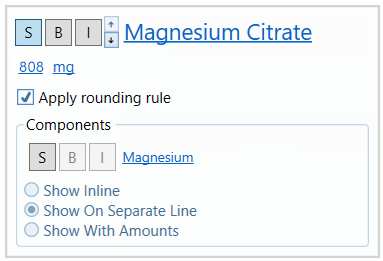
- Click the S to hide the Ingredient on the Label.
- Now click the Magnesium Nutrient (above the line in the label). This box will appear:
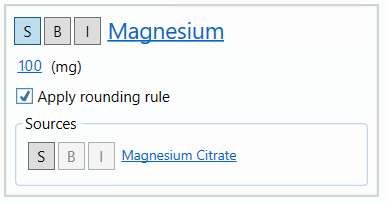
- Under Sources Click S next to Magnesium Citrate. It will now appear above the line, either under the Magnesium nutrient or inline next to the nutrient, as the source.
Promote the Melatonin Component
- Click the Melatonin Powder Ingredient (below the line in the label).
This box will appear: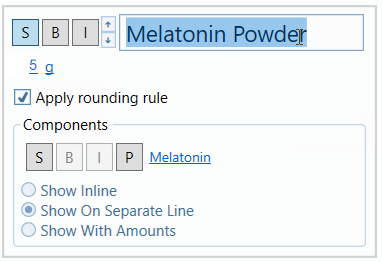
- Click on the “P” (Promote) next to the Melatonin component. The component will appear on the label, left-justified underneath the Melatonin Powder. Since the Melatonin Powder is 97% Melatonin, the component amount more accurately reflects the amount of Melatonin in the supplement. Remove the Melatonin Powder from the label.
Supplement Facts Label Final View
After all your modifications are complete, your labels should look like this:
If desired, you could make further modifications, including editing the Magnesium Citrate source directly to say “(as magnesium citrate)” in parentheses.
Remember, the melatonin was not included in Genesis R&D Supplements and does not have a %DV. It was added on the fly during the creation of the Melatonin Powder Ingredient.
The magnesium is an included component of the program. It will appear in the correct FDA-compliant position on the label with its calculated %DV.
For more details on creating an Ingredient, please watch this tutorial:

Other posts you might be interested in
View All Posts
Trustwell News
3 min read
| December 12, 2019
How to Export Files from Genesis R&D Supplements
Read More
Trustwell News
42 min read
| December 20, 2019
How to Import Ingredient & Formulation Files into Genesis R&D Supplements
Read More
Product Formulation
29 min read
| September 27, 2021

